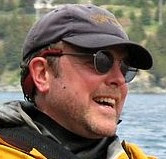 Day 5 of our 6-day paddling trip was outstanding. We started from our magical campsite at Julies Harbour (no sign of the rumoured ghost) and ended at Triton East after paddling 33 kms.
Day 5 of our 6-day paddling trip was outstanding. We started from our magical campsite at Julies Harbour (no sign of the rumoured ghost) and ended at Triton East after paddling 33 kms. Here is our Julies Harbour camp. A great spot (sheltered, level and lots of freshwater) with lots of history to explore.
Here is our Julies Harbour camp. A great spot (sheltered, level and lots of freshwater) with lots of history to explore. This is the view paddling out of Julies Harbour and into Badger Bay. We paddled south by Gull Island and into Wild Bight.
This is the view paddling out of Julies Harbour and into Badger Bay. We paddled south by Gull Island and into Wild Bight. On the southeast side of Wild Bight, we found Pissamare Falls (above), a dramatic waterfall on Badger Bay Brook. This was the scenic highlight of our trip. We decided to stop and hike up the falls for lunch.
On the southeast side of Wild Bight, we found Pissamare Falls (above), a dramatic waterfall on Badger Bay Brook. This was the scenic highlight of our trip. We decided to stop and hike up the falls for lunch. The view was breath-taking.
The view was breath-taking. We continued paddling north up the east side of Badger Bay under ideal conditions. We found several good beaches suitable for breaks. We stopped at Locks Harbour, which was another good camping spot (but lacking a stream). The photo above shows Isabelle at the mouth of Badger Bay, with White Point on the right and Triton Island on the left. We paddled north to Triton Island and took a short break on a cobble beach on the north side of Great Denier Island. We paddled on across Grand Dismal Cove (no place to land). When we came around Ragged Point and turned west, we found half a dozen huge icebergs directly in our path.
We continued paddling north up the east side of Badger Bay under ideal conditions. We found several good beaches suitable for breaks. We stopped at Locks Harbour, which was another good camping spot (but lacking a stream). The photo above shows Isabelle at the mouth of Badger Bay, with White Point on the right and Triton Island on the left. We paddled north to Triton Island and took a short break on a cobble beach on the north side of Great Denier Island. We paddled on across Grand Dismal Cove (no place to land). When we came around Ragged Point and turned west, we found half a dozen huge icebergs directly in our path. The icebergs were sculpted into wild spires and drydocks. They were slowly breaking up and in places the water was full of frazzle ice, crackling and fizzing as it melted.
The icebergs were sculpted into wild spires and drydocks. They were slowly breaking up and in places the water was full of frazzle ice, crackling and fizzing as it melted. We kept a safe distance from the unstable bergs.
We kept a safe distance from the unstable bergs. As we passed this berg, a loud crack rang out. The berg wobbled slowly in the water, sending off big waves. A huge bergy bit floated to the surface, broken off underwater. We paddled hard in the opposite direction, half expecting the iceberg to roll.
As we passed this berg, a loud crack rang out. The berg wobbled slowly in the water, sending off big waves. A huge bergy bit floated to the surface, broken off underwater. We paddled hard in the opposite direction, half expecting the iceberg to roll.We paddled by Big Triton Island and into Little Triton Harbour. The old community of Triton East offered a sheltered landing spot and good camping behind the cabins. A brief rain shower started just as we finished pitching our tent.
What a memorable day! A huge waterfall, awesome icebergs, sun, rain ... a bit of everything. After all the paddling, we gobbled down supper and slept like logs.


































 There were 7 icebergs visible across Note Dame Bay on this crossing.
There were 7 icebergs visible across Note Dame Bay on this crossing. 





